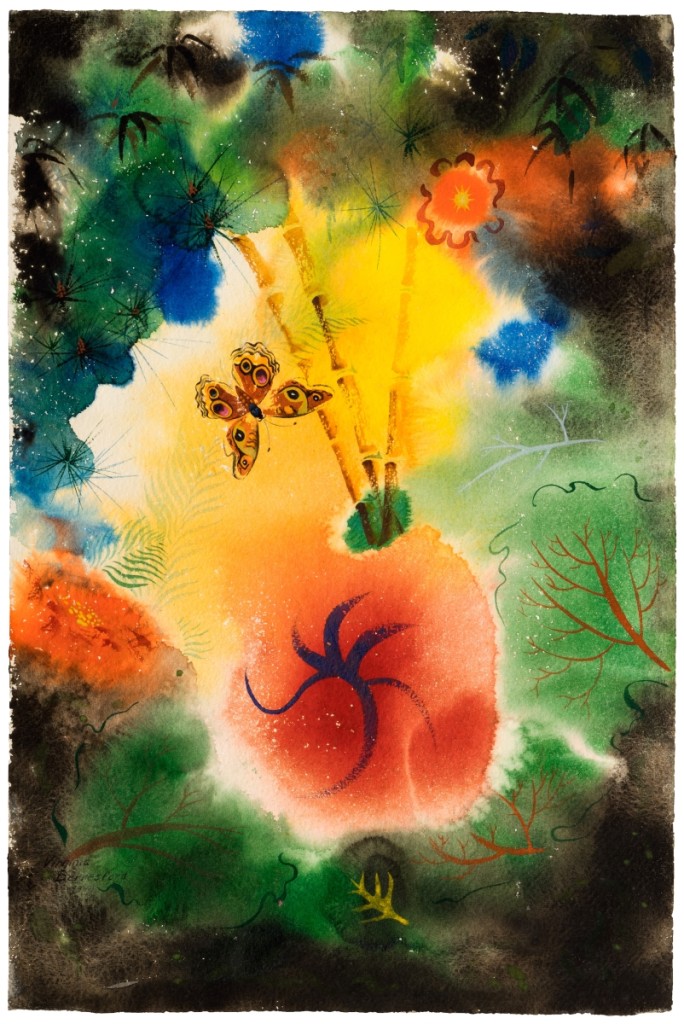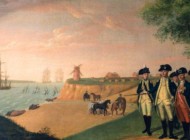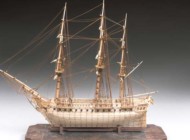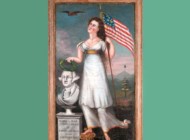
“Southern Morning” by Virginia Berresford, 1944. Watercolor on paper, 20¼ by 13½ inches. ©The Estate of Virginia Berresford, Courtesy D. Wigmore Fine Art, Inc.
By Laura Beach
BOCA RATON, FLA. – Stripped of the gilded bacchanal that is Art Basel Miami, Florida’s cultural life, at least in the outsider’s fevered imagination, resembles a book by Carl Hiaasen. It is wild and weird and wonderful, a place where the outlandish is right at home.
Like most stereotypes, this one contains only a kernel of truth. As the organizers of “Imagining Florida: History and Myth in the Sunshine State” reveal, Florida artists – residents and visitors alike – are extraordinarily varied. How then to find commonality in art characterized by diversity?
Three years in the making and on view through March 24, the blockbuster exhibition at the Boca Raton Museum of Art features more than 200 paintings, prints, photographs and artifacts reflecting 227 years of Florida history. The museum drew liberally from collections assembled by Sam and Robbie Vickers, Cici and Hyatt Brown and Scott P. Schlesinger, as well as from more than 30 institutions across the United States and in Europe. The works displayed date from Mark Catesby’s Natural History of Carolina, Florida and the Bahama Islands, a two-volume book of 1742, to Garry Winogrand’s 1969 photograph of spectators viewing the Apollo 11 moon launch at Cape Kennedy, a transitional moment in the state’s history.
Irwin M. Lippman, the museum’s executive director, began envisioning a comprehensive show of Florida art in 2003, after he left Columbus, Ohio, for Fort Lauderdale. The project got underway in earnest after he took charge of the Boca Raton Museum of Art in 2014. The executive director writes that the museum organized a “small but seminal” presentation of what he calls the art of “Old Florida” in 1990. Three decades on, with mangrove swamps and orange groves yielding daily to the pressures of development, the fecund, exotic landscape of “Old Florida” is all the more compelling.
Florida’s artistic heritage is deep but not widely known. As Lippman explains, “A continuum of art making paved the way for other artists to come here. Martin Johnson Heade, who set up in a Flagler hotel in St Augustine, came for his health. Winslow Homer came for the great fishing, the best in America. Frederic Remington came at the behest of Harper’s magazine to cover soldiers on their way to the Spanish-American War. One of the great surprises in the exhibition is the work of Philip Pearlstein, who did extraordinary watercolors of his time in the military here.”
University of South Florida professor Raymond Arsenault has characterized the “Florida Dream” as “the centuries-old promise of perpetual warmth, health, comfort and leisure.” He expands on the notion in Imagining Florida: History and Myth in the Sunshine State, published by the Boca Raton Museum of Art and distributed by the University Press of Florida, writing, “it may be necessary to talk instead of a dreamscape – a cultural backdrop capable of inspiring a wide variety of dreamlike images and expectations.” Dreamscape and reality merge in “Imagining Florida,” says Arsenault, adding, “if we look closely, we can catch glimpses of how the dreamscape influences and entices individuals to revise their identities to the point of reinvention – sometimes to their benefit and sometimes not.”
 To tell the story, Lippman chose two guest curators eminently up to the task. Art historian Jennifer Hardin, a student of John Wilmerding’s who earned her doctorate at Princeton before rising to the position of chief curator at the Museum of Fine Arts in St Petersburg, displays her comprehensive knowledge of Florida art in the context of the broader American tradition. Co-curator Gary Monroe, an accomplished photographer, collector and author who drew heavily on his own experience, is more subjective and personal in his approach to the photographs, folk art and pop-culture artifacts he selected for the show.
To tell the story, Lippman chose two guest curators eminently up to the task. Art historian Jennifer Hardin, a student of John Wilmerding’s who earned her doctorate at Princeton before rising to the position of chief curator at the Museum of Fine Arts in St Petersburg, displays her comprehensive knowledge of Florida art in the context of the broader American tradition. Co-curator Gary Monroe, an accomplished photographer, collector and author who drew heavily on his own experience, is more subjective and personal in his approach to the photographs, folk art and pop-culture artifacts he selected for the show.
“I wanted to say something different about Florida relative to exhibitions I’d seen in the past. It led me to include work that had rarely if ever been seen, as well as themes, such as the environment and labor, that hadn’t really been addressed in previous, comprehensive exhibitions,” notes Hardin, whose study starts with naturalists Mark Catesby, William Bartram and John James Audubon and ends, more or less, with the modernists Ralston Crawford, Doris Lee, Milton Avery, Sally Michel and the aforementioned Pearlstein. Those in between, from Heade and George Inness to John Singer Sargent and Frederick Frieseke, are a varied lot.
Hardin provides a detailed chronology. Briefly summarized, naturalists were the first to depict Floridian subjects in the mid-Eighteenth Century. They were followed in the early to mid-Nineteenth Century by artists such as Charles Bird King and George Catlin, who portrayed Florida’s Native American population. The first great wave of artists came after the Civil War and coincided with the opening of tourist hotels by entrepreneurs such as Henry Flagler and Henry Plant. Bostonian William Morris Hunt sought refuge in Florida after the great Boston fire of 1872 destroyed his studio. Scribner’s sent Thomas Moran to Florida on assignment in 1877. His wife, Mary Nimmo Moran, made important, exceedingly rare etchings of Florida. Heade opened a studio in St Augustine at Flagler’s Hotel Ponce de Leon, completed in 1888. Louis Comfort Tiffany’s only documented visit to St Augustine, in 1883, was a productive one. Sargent made his first and only trip to Florida in 1917 at the invitation of John D. Rockefeller and was mainly impressed with James Deering’s sumptuous villa, Vizcaya. Frieseke did a series of memory paintings in the 1920s, drawing on his childhood recollections of time spent around Jacksonville. The beginning of the automobile era, represented by the 1928 opening of the Tamiami Trail connecting Tampa and Miami, had vast implications for Florida’s cultural life.
Hardin notes that Realist and American Scene painters worked concurrently with Modernists during the 1930s and 1940s. She gives a shout-out to the Maitland Art Center, which hosted artists-in-residence Ralston Crawford and Milton Avery. Avery also vacationed in the Keys with his wife, Sally Michel. The scholar writes, “These Modernists approached Florida with a radically different visual vocabulary than earlier artists. Yet the visual relationship to the Nineteenth Century landscape tradition was not forgotten…” Post 1970, Robert Rauschenberg and James Rosenquist both made art in Florida, with Rauschenberg on Captiva Island much of the year and Rosenquist working out of a studio in Aripeka, though Hardin leaves an examination of these artists for another time.
Hardin says her most important discoveries included watercolors by Virginia Berresford (1904-1995), a Modernist who first visited the Keys in 1932 before returning to Miami with her naval-officer husband. “From 1934 to 1946, she created responses to the Florida landscape that are unparalleled. These works were inspired by both her environment and her imagination,” writes the scholar. Along with WPA-era Tallahassee mural studies by Eduard Buk Ulreich (1889-1966) and “Florida Chain Gang” by Madeline Hewes (1905-1969), the Berresford paintings were barely known and rarely shown. To this list of finds Hardin adds Homer’s late 1904 watercolor “The Shell Heap,” depicting Homosassa on Florida’s Gulf Coast. “It has been in private hands since early in the Twentieth Century before being acquired by Art Bridges recently. We’re fortunate to have it in the exhibition,” she says.
-1024x818.jpg)
Untitled (Mowing Eel Grass) by Bruce Mozert, Silver Springs Publicity Still, circa 1950. Gelatin silver print, 16 by 20 inches. Collection of Lisa Stone ©Estate of Robert Bruce Mozert.
Gary Monroe has made a career of documenting the disappearing Florida cultural scene. His timely publications include, among many others, a book on the photographer E.G. Barnhill and multiple volumes on the African American landscape painters known collectively as the Highwaymen. Monroe drew from his deep background to cull images for “Imagining Florida,” balancing art photography against arresting commercial work and revealing vernacular images. He is particularly proud to have secured six photographs Henri Cartier-Bresson took in Miami in 1957, noting, “I don’t think they have ever been seen as a group, at least not in Florida,” and another three that Robert Frank shot for The Americans. “I’d drive 100 miles to see these photographs alone,” he says.
Monroe calls attention to the relatively unsung genius of Bruce Mozert (1916-2015), official photographer for Silver Springs, an early Florida theme park. Mozert promoted Florida’s mid-Twentieth tourist boom by creating ingenious, widely distributed images of comely young women going about their daily routines underwater. “The mundane scenes looked weirdly real at first glance,” writes Monroe, adding, “It can easily be said that his work predated the postmodern interest in directorial photography. Indeed, his work became the bedrock to subsequent generations of artists who staged or synthesized images.”
The guest curator also spotlights the work of commercial photographer Loyd Sandgren (1916-2001), whose shots of everyday life straddle the banal and bizarre; Bunny Yeager (1929-2014), the former model who found commercial success as a creator of pin-up photos; and Gleason Waite Romer (1887-1971), whose hand painted photograph “Parrot Jungle” blends art and commerce. “Romer made beautiful images of everything he aimed his camera at – descriptive, insightful and compellingly interesting,” Monroe says.
For the catalog’s cover, designer Joel Suissa chose the photograph “Winter Visitors from Nearby Trailer Park, Picnicking Beside Car on Beach, Near Sarasota, Florida, 1941” by Marion Post Wolcott (1910-1990). Wolcott is one of several social documentarians in the show who worked at the invitation of the Farm Security Administration during the Great Depression. Her wry image, which pokes fun at snowbirds, was recently acquired by the Boca Raton Museum of Art.
Including what the organizers call “material culture” – in this case a miscellany of folk art and collectibles – was an inspired touch and a reminder that Floridians have at times been indifferent to the canons of conventional good taste. Monroe’s favorite artifacts include souvenir walking sticks with carved alligator handles, Silver Springs television trays and the Silver Springs Mileage and Route Information Meter. A precursor to Google Maps and Garmin, the clever device made by the Timely Manufacturing Company in Daytona Beach was available at most gas stations and provided mileage and route information to tourists. Silver Spring’s pious owners discontinued the Mileage Meter after discovering the public had learned how to gamble with it.
The ascendance of corporate, international Disney marked the end of “Old Florida.” Monroe writes, “Florida is an increasingly man-made place, and those of us who have deep roots here have both scant and grand memories because so much is gone, as if it never existed.” Still, what remains of Florida’s wild, untamed beauty, so unlike that of the rest of the continental United States, enchants and amazes, leaving the tantalizing promise of more exhibitions like this one to come.
The Boca Raton Museum of Art is at 501 Plaza Real, in Mizner Park. For more information, www.bocamuseum.org or 561-392-2500.













.jpg)



